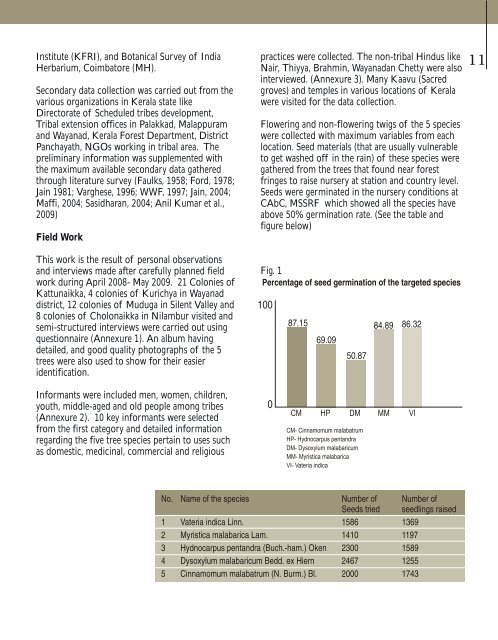Images - IUCN
Images - IUCN
Images - IUCN
You also want an ePaper? Increase the reach of your titles
YUMPU automatically turns print PDFs into web optimized ePapers that Google loves.
Institute (KFRI), and Botanical Survey of India<br />
Herbarium, Coimbatore (MH).<br />
Secondary data collection was carried out from the<br />
various organizations in Kerala state like<br />
Directorate of Scheduled tribes development,<br />
Tribal extension offices in Palakkad, Malappuram<br />
and Wayanad, Kerala Forest Department, District<br />
Panchayath, NGOs working in tribal area. The<br />
preliminary information was supplemented with<br />
the maximum available secondary data gathered<br />
through literature survey (Faulks, 1958; Ford, 1978;<br />
Jain 1981; Varghese, 1996; WWF, 1997; Jain, 2004;<br />
Maffi, 2004; Sasidharan, 2004; Anil Kumar et al.,<br />
2009)<br />
Field Work<br />
This work is the result of personal observations<br />
and interviews made after carefully planned field<br />
work during April 2008- May 2009. 21 Colonies of<br />
Kattunaikka, 4 colonies of Kurichya in Wayanad<br />
district, 12 colonies of Muduga in Silent Valley and<br />
8 colonies of Cholonaikka in Nilambur visited and<br />
semi-structured interviews were carried out using<br />
questionnaire (Annexure 1). An album having<br />
detailed, and good quality photographs of the 5<br />
trees were also used to show for their easier<br />
identification.<br />
Informants were included men, women, children,<br />
youth, middle-aged and old people among tribes<br />
(Annexure 2). 10 key informants were selected<br />
from the first category and detailed information<br />
regarding the five tree species pertain to uses such<br />
as domestic, medicinal, commercial and religious<br />
practices were collected. The non-tribal Hindus like<br />
Nair, Thiyya, Brahmin, Wayanadan Chetty were also<br />
interviewed. (Annexure 3). Many Kaavu (Sacred<br />
groves) and temples in various locations of Kerala<br />
were visited for the data collection.<br />
Flowering and non-flowering twigs of the 5 species<br />
were collected with maximum variables from each<br />
location. Seed materials (that are usually vulnerable<br />
to get washed off in the rain) of these species were<br />
gathered from the trees that found near forest<br />
fringes to raise nursery at station and country level.<br />
Seeds were germinated in the nursery conditions at<br />
CAbC, MSSRF which showed all the species have<br />
above 50% germination rate. (See the table and<br />
figure below)<br />
Fig. 1<br />
Percentage of seed germination of the targeted species<br />
100<br />
0<br />
87.15<br />
69.09<br />
50.87<br />
84.89 86.32<br />
No. Name of the species Number of Number of<br />
Seeds tried seedlings raised<br />
1 Vateria indica Linn. 1586 1369<br />
2 Myristica malabarica Lam. 1410 1197<br />
3 Hydnocarpus pentandra (Buch.-ham.) Oken 2300 1589<br />
4 Dysoxylum malabaricum Bedd. ex Hiern 2467 1255<br />
5 Cinnamomum malabatrum (N. Burm.) Bl. 2000 1743<br />
11

















